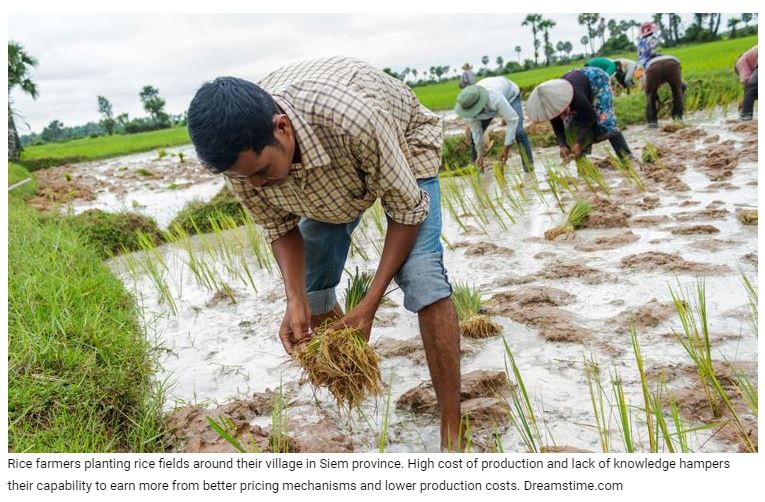Cambodia’s goal of exporting rice competitively hampered by high pricing
The Kingdom’s rice industry has often profited from the international markets because of its premium or fragrant rice which fetches high values.
However, the country has been losing out to cheaper priced rice or white rice when compared to neighbouring countries such as Vietnam and Thailand that supply the vast majority of white rice to the world market at highly competitive prices or even much cheaper when compared to Cambodia.
This scenario was lamented by the Minister of Agriculture, who has urged exporters to focus more on white rice exports to tap the larger global low-cost market.
“We are busy focusing only on premium fragrant rice and forgot about Vietnam, who is taking the international markets advantage for demand of white rice, so we should turn to processing more white rice for export instead of merely focusing on premium rice,” he said.
He said by continuing focus on the premium fragrant rice with a specific market segment, it would keep Cambodia out of the world’s rice-producing countries and may leave farmers lagging behind with lost opportunities and physical benefits.
Cambodia produce more than 10 million tonnes of paddy a year and only about 3 million tonnes are premium fragrant paddy, according to Veng Sakhon, the minister.
He said according to an unofficial data Cambodia, exports most of its paddy to Vietnam, exceeding at times, 2 million tonnes a year.
Research on pricing revealed that in Vietnam, the price of 5 percent broken rice was priced at $493 a ton as of August while the 5 percent broken rice of Thailand was priced at $473 a tonne. In Cambodia, its 5 percent broken rice was priced at $510 per ton, rendering it uncompetitive.
As of September this year, paddy cultivation was carried out on 2.7 million hectares nationwide, according to figures obtained from Ministry of Agriculture, Forestry and Fisheries (MAFF).
A rice industry insider has applauded the minister’s remarks, but claimed that Cambodia still has a long way to go to address these shortcoming as the issue of high production costs remains a challenge that has made Cambodia non competitive in almost all areas.
Lun Yeng, Secretary-General of the Cambodia Rice Federation (CRF), said the markets are still a problem, and a matter to be addressed cohesively and coherently to get solutions.
“We support the minister’s recommendation, but now if we want to process white rice for export, we have to do it on a large scale at a price which is more competitive than neighboring countries to compete in export markets,” he said.
“We cannot produce on a large scale with high cost and sell at a low price. We already know that the recurring challenges today are high production costs and transporting costs.”
Yeng said, compared to Vietnam, both production and transportation costs are low, where the delivery of white rice is not done by containers, but loaded directly into vessels as bulk cargo at a low cost.
“We really want to do it, but it is not profitable. Our production cost is already high, so we cannot sell at low prices,” he said.
He said that Cambodian farmers currently produce a lot of white rice per year, and most of the paddy is exported to Vietnam rather than processing it domestically.
Figures from MAFF shows that Cambodia exported 488,775 tonnes of milled rice in the first nine months of this year, up 22.6 percent compared to the same period last year.
Compared with the Thais who exported 2.89 million tonnes in the first half of 2020, a drop of 34 percent year on year, while Vietnamese exported about 3.5 million tonnes, an increase of 5.6 percent.
Cambodia expects to export more than 800,000 tonnes of milled rice this year and reach the 1 million tonne milestone target by 2022.
Yeng said Cambodia also exported about 30 percent of its white rice to the international markets, most of which was exported to the EU market.
He said, however, since the Europe Commission imposed safeguard measure on Cambodian rice, the produce could not compete in the European market.
“Therefore, fragrant rice is still our strength in the market. We do not focus on quantity, the important thing is that we can produce with profitability and ensure the well-being of the rice sector,” he said
According to Yeng, Cambodia currently has 70 rice exporters nationwide, 60 of whom are members of CRF. He said there are 120 rice mills processing paddy for export, and can process a total of 1.2 million tons per year.
Mey Mon, vice president of Beung Leach Sambophal rice community in Kampong Chhnang province, which has entered into a contract farming initiative with Amru Rice, said that farmers in the community produce premium quality fragrant paddy, known as “Pkar Romdul” and wish to grow white rice paddy if they had sufficient water.
“We can only do it once a year during the rainy season because there is a lack of water. We depend on rain water. We want a water canal system that allows us to grow rice three times a year to enable us to produce white paddy during the dry season,” he said.
Mon currently farms on 4 hectares of land that yields 7 tonnes in total per year. He said contract farming provides farmers a higher prices of up to 1,620 riel per kilogram compared to 1,200 riels offered by brokers.
Source: https://www.khmertimeskh.com/50769631/cambodias-goal-of-exporting-rice-competitively-hampered-by-high-pricing/


 English
English




